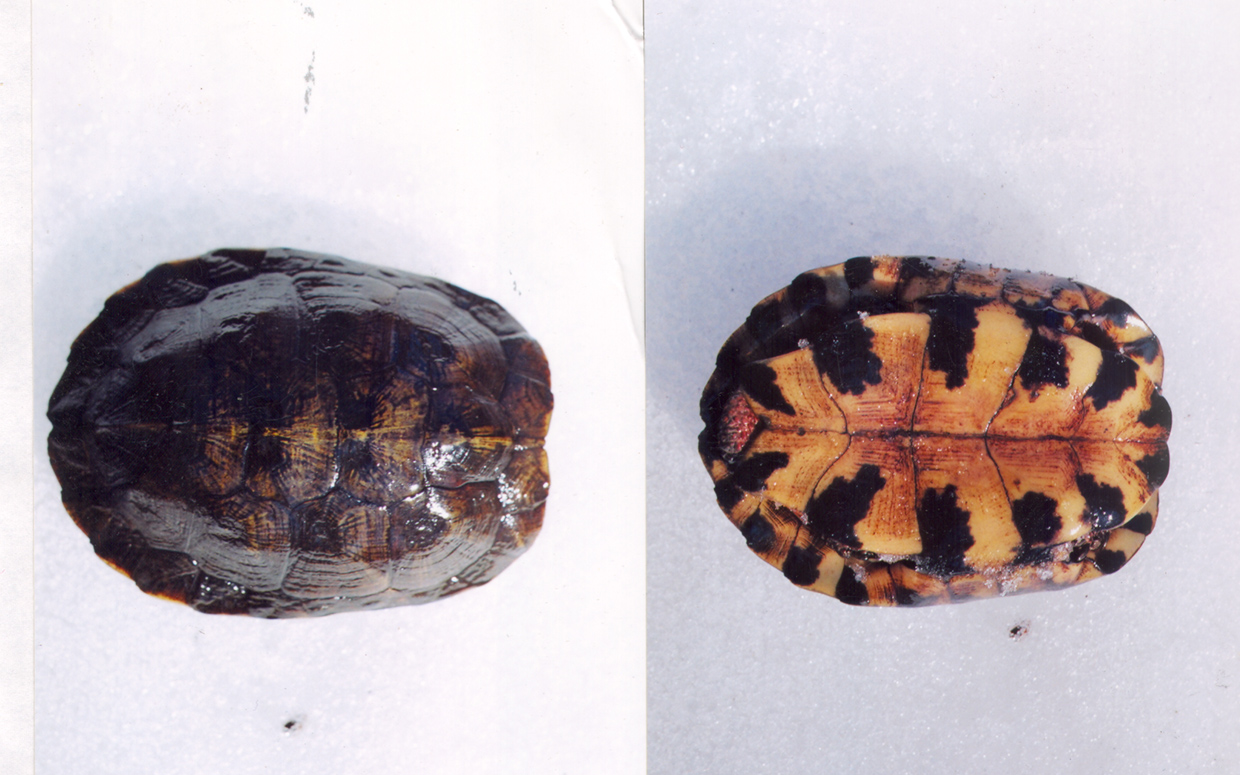
A sustainable landscape includes the habitat components needed by indigenous plants and animals. Turtles may carry their homes on their backs, but they still need suitable habitat to live in, in particular, for hibernation, for nesting, and to sustain their food supply.
Wood Turtles (Glyptemis insculpta ) are semi-aquatic and semi-terrestrial. (See Photos above, of a torpid, hibernating wood turtle.) They need clean, well-oxygenated rivers or large streams for hibernation, and also for feeding on stream bottom invertebrates, especially in spring and fall.
Like most other turtle species, they need sunny areas with well drained soil, easy to dig in, for nesting.
These large, fast-walking turtles also seem only to be found along rivers and streams with broad, naturally vegetated buffers for terrestrial foraging at least three hundred feet wide on average, in our experience. As intelligent, likable turtles (reportedly the most intelligent reptile) and as large, conspicuous species, I suspect they are less vulnerable to collection if hidden in a broad thickly vegetated river valley. This species is omnivorous; while on land it eats plant matter as well as earthworms, which it can trick into emerging from the ground by tapping with its foot to cause vibrations, I have read.
Wide naturally vegetated buffers, along feeder streams as well the main stem, also maintain the species’ key habitat requirement of good water quality with high dissolved oxygen levels, and stable in-stream habitat, without surges of high flows and spikes of warm water temperatures. A perennial stream or river that is fit for wood turtles has rocks, sticks, and logs free of black scum fed by excessive nutrients; it is free of large sediment bars, severe bank erosion, and scouring. It is large enough not to freeze solid in winter. Healthy instream habitat is needed both for hibernation and also for the Wood Turtles’ invertebrate food supply during its aquatic phase.
Like E. Box Turtles, Wood Turtles (Glyptemis insculpta, formerly Clemmys insculpta) are on the official Connecticut “NDDB” list; in fact they are even rarer. They are absent from many suburban Connecticut towns and from Long Island, with few rivers. (NDDB is jargon for Natural Diversity Data Base). Spring is a good time to detect presence of a wood turtle population along a large stream or river, because their distinctive tracks will be found on sandy or muddy banks. Like E. box Turtles , they need oxygen during hibernation. By contrast, two common Connecticut turtle species, snappers and painted turtles, have anaerobic metabolism to use during hibernation, usually on the muddy bottom of a waterway or pond. Another key similarity to box turtles is the fact that both species spend much of their time foraging on land, and are vulnerable to habitat fragmentation and roadkill.

Connecticut has a “Special Animal Form” to be used for reporting occurrences of animal species such as Wood Turtle, E. Box Turtle, and Bog Turtle, that are either rare, in serious decline, or dependent on rare habitats. I can e-mail you a sample reporting form if you contact me @sigrun.gadwa@sbcglobal.net, and will provide help with records of listed turtles if you share your data with me, as these creatures are of particular scientific and conservation interest to me. I have a DEP Scientific Collectors permit to handle turtles for collection of data not required by the CTDEP, such as sex, age (found by counting growth rings), height, and size; please e-mail me if you would like to learn how to monitor populations of listed turtles (volunteer basis). The Special Animal Form may or may not be downloadable from the CTDEP website, but would certainly be provided upon request via e-mail, by CTDEP Wildlife Division staff, e.g., Laurie Fortin. An informative scientific overview of wood turtles, as well as Eastern box turtles, may be found in Turtles of North America by Ernst, Lovich , and Barbour, 1994, published by The Smithsonian Institution.